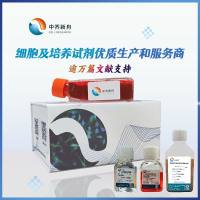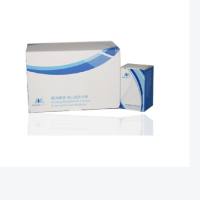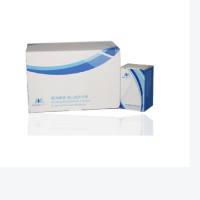Long-PCR Reagents and Guidelines
互联网
General Guidelines for Long-PCR Conditions and Enzyme Mixtures
Efficient Long-PCR results from the use of two polymerases: a non-proofreading polymerase is the main polymerase in the reaction, and a proofreading polymerase (3' to 5' exo) is present at a lower concentration. Following the results of Cheng et al. (1) we have had success using Tth (ABI/Perkin-Elmer) as the main-component polymerase and Vent (New England Biolabs) as the fractional-component polymerase.
For PCR with low-complexity templates (e.g., plasmid and cosmid inserts)
50 microliter reaction in 1X Long-PCR buffer (5X recipe below)
1-2.5 U Tth
0.02 U Vent
0.2 mM each dNTP
20-40 pmoles each primer (400-800 nM)
1.1-1.2 mM Mg(OAc)2
10^5 -10^7 template molecules
For PCR with moderate-complexity templates (e.g., bacterial genomic DNA)
50 microliter reaction same as above except for the following change: 0.1 U Vent. This Vent concentration has not been completely optimized and more Vent might be better, but this concentration works well.
For PCR with high-complexity templates (e.g., human genomic DNA)
Others have informed us that conditions similar to those above work well.
--------------------------------------------------------------------------------
Long-PCR Buffer
In our hands tricine buffer works well with Tth but not as well with Taq. The pH is probably critical to the efficiency of amplification of long targets (1).
5X Long-PCR Buffer
85 mM KOAc
25 mM Tricine pH 8.7 (adjust pH of stock solution with KOH)
8% glycerol
1% DMSO (1 to 4% works)
A 5X buffer stock containing 5% DMSO (1% final conc.) can easily be made using 1 M Tricine and 1 M KOAc stock solutions as follows:
10 ml 5X buffer
4.25 ml 1M KOAc
1.25 ml 1M Tricine, pH8.7 @ 25 degrees C (with KOH)
4.00 ml glycerol
0.50 ml DMSO
--------------------------------------------------------------------------------
Cycle times and temperatures
Generally, we have been using two temperature cycles with one annealing/extension step @ 68 degrees C and a short melting step @ 94 degrees C. Presently, a rough formula for calculating annealing/extension times is 1 min + (2.5 sec/100 bases) = n. The constant one minute is probably necessary for primer annealing/extension to occur; at 68 degrees C the kinetics of primer-template annealing and melting may become the limiting factor in the rate of primer extension.
Generic Long-PCR Program
Initial melting 94 degrees C 10-15 sec
Cycles 1-15 94 degrees C 10 sec, 68 degrees C for n min (15 times)
Cycles 16-30 94 degrees C 10 sec, 68 degrees C for n min +15 sec/cycle (15 times)
The 15 sec cycle extension for cycles 16-30 may be necessary for only the longest PCR (>15-20 kb), please experiment.
Hot Starts
I use a hot start method for all of my L-PCR. I split the reaction into two parts: a template/primer fraction which is 3/4 or 4/5 of the reaction volume, and a polymerase fraction which constitutes the remaining 1/4 or 1/5 of the reaction. Each fraction is 1X for buffer concentration. The polymerase fraction contains only polymerase, buffer and water; all other components are included in the template/primer fraction. I put the template/primer fraction in the tube and heat in the PCR machine to 94 degrees C for 10 sec. to denature. I then add the polymerase fraction during the first annealing/extension step. Alternatively, after denaturing, an 80 degree step can be used for adding the polymerase (P.E.).
--------------------------------------------------------------------------------
Picking Primers
We have had success using the following guidelines for primers (these are not inviolable rules, they are simply guidelines):
Primers are 20 to 23 bases in length
G+C = 12 bases
A+T = 8 to 11 bases
Ideal Tm = 60 to 68 degrees C in 85 mM salt. These values were calculated using the PrimerSelect program of DNAStar. A working primer might have a Tm significantly lower than 60 degrees C and we have used successfully primers with Tm values below 50 degrees C, but avoid this if possible-especially if you are doing genomic DNA templated reactions. The largest PCR we have done is about 20 kb using the positive control primers from the PCR-XL kit available from Perkin-Elmer; these primers both have Tm values of about 60 degrees C using PrimerSelect from DNAStar. Other programs probably give similar results.
Avoid primer hairpins.
Avoid primers with 3' complementarity (results in primer-dimers). These last two problems can be avoided with the aid of a primer-picking program like PrimerSelect.
One additional piece of advice: Pick primers with A/T-rich 3' ends if possible (2). G/C-rich 3' ends may be too sticky and give non-specific products. Using this additional rule primer length might increase to 25 or 26 bases. We have not yet used this rule in our primer-picking but we are experimenting.
REFERENCES
1. Cheng, S., Fockler, C., Barnes, W., Higuchi, R. Effective amplification of long targets from cloned inserts and human genomic DNA. Proc. Natl. Acad. Sci. 91, 5695-5699 (1994).
2. Crameri, A. and Stemmer, W. 10^20-Fold aptamer library amplification without gel purification. Nucleic Acids Research 21, 4410 (1993)
上一篇:反转录生产cDNA链以及PCR扩增 下一篇:Real time PCR-ABI Prism 7000









